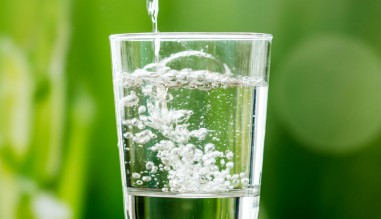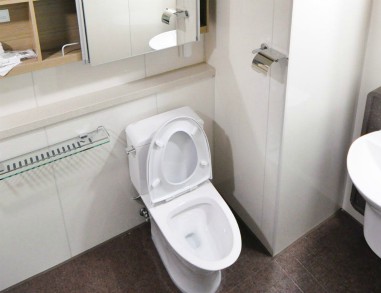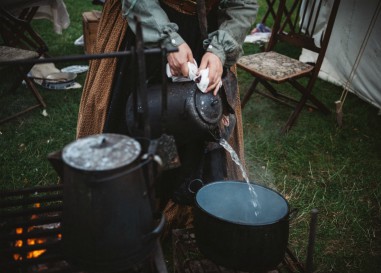
I am a camper, hunter, hiker and survivalist. But water filtration has been one of those things I only think about when in those environments. But recently I had a major wake up call about how important it is every day. And my habits have changed due to the wake up call.
So what was my wake up call…? Well it started at the gym. I was working out and went to the water fountain to get a drink between sets. As I watched the kid in front of me drinking from the fountain, he put his WHOLE mouth over the spout as he was drinking the water… I then saw another close encounter nearly of the same thing by another person. I was totally grossed out.
As I decided today was not the day to drink from the fountain, I began to think about all the studies that demonstrated that ice cubes from most ice machines contained more bacteria and germs than the water from your toilet. That is not a comforting thought.
As I was losing my focus on working out… I thought about how much emphasis was put on washing our hands to reduce the likelihood we would get sick from touching things other people handled that were sick. Now don’t get me wrong, I am all about getting exposed to germs to build your resistance, but doing a few things to cut down your risks is prudent.
With those thoughts in mind, I thought why am I not more cautious about the water I drink. Since my guess is, I am being exposed to as many if not more pathogens every time I drink a glass of water. To make things worse, I started thinking about where my water comes from that I drink at home. Damn…. it may come from the sewage treatment plant. Now that sounds encouraging… NOT!!!…..
Boil Water Alerts

Furthermore, I was reading a report from the Bi-partisan Policy Center published on July 12, 2018 and it really made me think more about this issue. The article stated that over 19 million American will fall ill every year due to poor water quality. This is not from lead or chemicals in the water, this is from bacteria (e-coli) or cysts (giardia or cryptosporidium) found in microbiological unsafe water.
In addition, the article states that during a three month period in 2015 there were 142 “boil” alerts in the United States. Now most of these were in small communities and rural areas, but they can happen anywhere any time. A smart person once told me that lead in your water will kill you over time but bacteria in your water will kill you next week.
Since most of us live in locations where the water system is old and aging, many of the water pipes are made of cast iron and are emitting various potential toxins into the water we use daily. These contaminates play an unknown role in our health. Thus, anything you can do to eliminate them from the water the better off you most likely will be.
What was not taken into account in the article was the number of people affected by natural disasters that did not have access to clean water, during disruptions caused by natural disasters such as tornadoes, hurricanes, floods, and electrical outages. The water system can be easily compromised. For example, the pressure can drop thus inhibiting the system’s ability to add chemicals and filtration, water treatment plants back up and clean water is contaminated and furthermore, there may be no clean water at all. Despite there being no clean water does not mean there is no access to water. It may be all around just not drinkable. In those cases, water filtration is essential.
What Is A Boil Advisory?

A Boil Water Advisory is a public health recommendation from your local water utility advising you and your family to boil your tap water before using it. This is in response to an event that could have allowed contaminants (usually bacteria or cysts) to enter the water distribution system.
Because the water quality is unknown, when you receive this advisory, you should assume the water is unsafe to drink and take the appropriate precautions. A boil order is usually only issued because either recent testing has shown the presence of organisms that could cause illness (e.g. fecal or E. coli bacteria), or technical/physical problems in the water system have significantly increased possibility of bacterial contamination.
Which Water Should I Boil?
During boil water advisories or boil water orders, you should boil or use nano-filtration to filter all water used for human and pet drinking, preparing all food, beverages, ice cubes, washing fruits and vegetables, or brushing teeth. Severely immune-compromised individuals should always boil or use nano-filtration to filter their tap water for these purposes or use a high end filter product that removes bacteria or viruses from the water. Infant formulas should also be prepared using boiled tap water or filtered water, at all times. In the event that boiling is not practical and you do not have a good filter, disinfect the water using household bleach.
Keep in mind that it is not necessary to boil tap water used for other home purposes, such as showering, laundry, or bathing. Adults, teens, and older children can wash, bathe, or shower; however, they should avoid swallowing the water. Small children and babies should be sponge-bathed. The issue I have with Boil Water Advisories is they usually come out after you have already drank or prepared food with contaminated water. Better to be on the front foot and always filter your water.
If you do not own a Nano-Filtration type of filter or Reverse Osmosis filter use these steps to boil your water.
- Fill a pot with unsafe water.
- Heat the water until bubbles come from the bottom of the pot to the top (rolling boil).
- Once the water reaches a rolling boil, let it boil for at least 1 minute.
- Turn off the heat source and let the water cool.
- Pour the water into a clean container with a cover for storage.
But I Have A Brita Water Pitcher, Do I Still Need To Boil My Water?
Yes, If your only filter device is a Brita, you will need to still boil your water. Brita is only designed to improve the taste and odor using granular activated carbon filters. A Brita water filter is not designed to be a real filtration technology. The Brita does not have anywhere near sub-micron filter rating it requires to remove bacteria, cysts or viruses from the water through filtration. If you need to filter your water to remove these pathogens (During a Boil Alert) you need a totally different filtration procedure/technology.
Unfortunately, Brita is only designed to be a water softener or a CTO filter (chlorine, taste, & odor). Brita claims to enhance taste by softening the water using ion exchange resin technology. This is a combination of activated charcoal made from coconut shells and mixed with resin granules that does the ion exchange, by exchanging softer ions and absorbing harder ions. The TDS of the water may not change or can even be increased from the carbon molecules. The activated charcoal can absorb quite a lot of smells making the water taste nicer. Unfortunately in a water crisis, the Brita is not capable of keeping your family safe.
What Should You Buy?
So I thought I should address this unknown water quality issue knowing that I cannot control all aspects of the water I drink from the time it leaves the water filter plant until the time it reaches my tap. You may or may not have heard about the 1993 Cryptosporidium outbreak in Milwaukee but over 400,000 people got sick and an unknown number of people died from drinking infected water and it all came right out of the tap of a major US city. I know that with a little bit of effort, I can really reduce my exposure and I wanted to know how hard it would be to do so.
So after much research, I got two things: A water pitcher that does nano-filtration down to the virus size and a portable water bottle that also does the same level of filtration. I first looked into a reverse osmosis system under the sink water filter. You can invest in an expense RO water systems and have a plumber come install it or try to do it yourself. This option will remove all pathogens from you water but for every 1 gallon of good water, the RO System generally wastes 3 to 4 gallons of water. I found the brand called Apec on Amazon that seems to be reasonable but I have not personally used it.
You can also look to do a whole home filter but according to my research, they do not remove bacteria or viruses from your tap water. This is because a whole house filter has to allow for high levels of water through put so you can run two showers and a dishwasher at once and the filters do not have the contact time with the water to remove small microbiological pathogens. I took the step to back myself up with solid water pitcher for my home that is a lot stronger than a Brita. Epic Water Filters makes a water pitcher called the Epic Nano that does sub-micron virus level removal of pathogens (bacteria, viruses, and cysts).
Related: Weighing The Options For Drinking Water
Delivery of the Epic Nano water filtration pitcher and Nalgene OG Outdoor water bottle was easy peasy. It is amazing how fast on line orders are processed and shipped. I was sent several emails tracking and informing me of my delivery status. Within 2 days my items were delivered to my door step and I took no time opening them and going through the products. Assembly of both Epic water products was as easy as it could get and with a couple prep processes done, I was filling my pitcher to go in the fridge and my Nalgene OG Outdoor water bottle to go on the workout backpack.
Let me tell you a little about the Epic Nano Water Filtration Pitcher. Because as you know, there are a number of products out there… and this is one you may wish to seriously consider. First, and very important, the Epic water filters are made in the USA. So I feel that is very important. Secondly, there are two types of Epic water filtration pitchers, Pure and Nano. The Epic Pure removes 99.9% of your traditional tap water contaminants, with the exception exception of bacteria, cysts and viruses.
The Epic Nano version removes 99.99% including all the same contaminates that the Epic Pure removes plus various bacteria, cysts and viruses. So for the money I feel the Nano’s added filtration is the best route to take. Since when a boil water advisory order is activated it is usually due to bacteria in the water along with other contaminants.
Here is a list of the contaminants that the Epic Nano water filter eliminates, it is impressive: Bacteria (E-Coli, Legionella Pneumophila, Hepatitis A, Salmonella, ), Viruses, Cysts (Giardia & Cryptosporidium), Herbicides, Pesticides, Lead, Fluoride, PFOA / PFOS, TTHM, Bromoform, Glyphosate (Roundup), Endocrine Disruptors, Atrazine, Xylenes and Trace Pharmaceuticals.
Secondly, the pitcher fits perfectly in the fridge. There is an easy to read indicator on the lid that lets you know when it is time to change the filter. This is a great added value as most folks will never remember the last time they changed their filter and when the next one is needed. In addition, the reservoir on top of the pitcher that holds to water to be filtered, is exceptionally large. Thus, when filled you are guaranteed the bottom will be full once filtered. The handle is easy to grip and the angle makes it simple to manage when the pitcher is full. I have been using it for over a month now and feel much better about the water I am drinking. In fact, I think due to that feeling I am drinking more water than before, which is a good thing. Actually the water also tastes a lot better than the water from my old Brita, so I am paying a little bit more with the Epic Nano but I am getting a lot more contaminants out of my water (and it tastes better).
A secondary benefit came to mind when using the Epic Nano water pitcher. I am a huge opponent of bottled water. I feel bottled water containers are among the most wasteful uses of plastic, not to mention that they are the cheapest plastic and probably leech into the water with chemicals. Bottled water containers are used by the millions and discarded with little consideration.
Using a filtration device such as the Epic Nano or the Nalgene OG water bottle could significantly reduce your need for bottled water. Simply using the Nalgene OG Outdoor water bottle or using a reusable container you can eliminated bottled water and help the environment at the same time. And it may be less expensive than buying bottled water as well. So now that you can consider water filtration as something not just for survival but daily use. It may be time for you to purchase a water filtration system for your home, travel and as part of you emergency preparedness plan.
